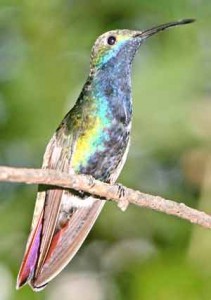Latest update February 20th, 2025 12:39 PM
Black-throated Mango
Sep 06, 2015 Features / Columnists, Interesting Creatures in Guyana
The black-throated mango (Anthracothorax nigricollis) is a mainly South American hummingbird species.
It is 10.2 cm long and weighs 7.2g. The longish black bill is slightly de-curved. The tail in both sexes has dark central feathers, the outer tail being wine-red tipped with black.
The male has glossy bright green upperparts. Its throat and chest are matt black, bordered with blue-green. The flanks are bright green, and the black of the chest tapers onto the belly.
The female black-throated mango on the other hand has bronze-green upperparts and white underparts with a black central stripe. Immature birds show some grey or buff feather tips on the head and wings, and have brown around the eyes.
The call of the black-throated mango is a high-pitched tsiuck, and the song is a buzzing hsl-hsl-hsl-hsl-hsl-hsl-hsl.
This species is very similar to the closely related green-breasted mango. Although the male black-throated mango has more extensive black on the underparts, this and other plumage differences are not always easy to confirm in the field because the birds appear all-black. The females of the two species can be almost inseparable, although the black-throated lacks the more extensively coppery upperpart of its relative.
It breeds from Panama south to northeastern Bolivia, southern Brazil and northern Argentina. It is also common on both Trinidad and Tobago. It is a local or seasonal migrant, with some birds moving up to 1000 miles, although its movements are not well understood.
This small bird inhabits open country, gardens and cultivation. Though it will adapt to human activity, it seems less of a generalist than for example the gilded sapphire (Hylocharis chrysura) or the sapphire-spangled emerald (Amazilia lactea).
The food of this species is nectar, often taken from the flowers of large trees. This hummingbird is also notably insectivorous, often hovering in open areas to catch flying insects. It appears to be somewhat picky regarding favourite food plants and often does not visit ornamental plants popular with many other hummingbirds, such as Erythrina speciosa or Stifftia chrysantha; certain ornamental Bignoniaceae like the fountain tree (Spathodea campanulata) seem more to this bird’s liking. While feeding, it has been observed to dominate over a glittering-bellied emerald (Chlorostilbon lucidus) and to be displaced by a gilded hummingbird, both considerably smaller species.
The black-throated mango’s breeding season lasts almost year-round in most of its range. It builds a tiny cup nest on a high, thin, and usually bare branch. For this it uses fluff like seed down, cladding the outside with lichen. Nests are maybe 35–40 mm wide and 25–30 mm tall on the outside and some 25 mm wide and 10–15 mm deep inside. The two all-white eggs measure c.15 by 9.5 mm. They are incubated by the female for 16 or 17 days, and fledging takes another 24.
At a black-throated mango nest in Cuyabeno Faunistic Reserve, Ecuador, it was noted that the tree was beset with Pseudomyrmex stinging ants. This was also noted at a green-breasted mango nest on San Andrés Island (Caribbean). It is likely that the ants would deter predators, but it is not known whether the birds deliberately select such trees for nesting. (Source: Wikipedia – The Free Online Encyclopedia)
Share this:
- Click to print (Opens in new window)
- Click to email a link to a friend (Opens in new window)
- Click to share on Facebook (Opens in new window)
- Click to share on WhatsApp (Opens in new window)
- Click to share on Twitter (Opens in new window)
- Click to share on Pinterest (Opens in new window)
- Click to share on Pocket (Opens in new window)
- Click to share on Tumblr (Opens in new window)
- Click to share on Reddit (Opens in new window)
- Click to share on LinkedIn (Opens in new window)
Related
Similar Articles

The Glenn Lall Show|| February, 14th, 2025
Follow on Tik Tok @Glennlall
THE BLUNT OF THE DAY

Sports
Feb 20, 2025
Kaieteur Sports- On the heels of the girl’s selection, the Guyana Under-21 boy’s hockey team has been selected for the 2025 PAHF Junior Challenge scheduled for Bridgetown, Barbados from 8th to...Features/Columnists
A flawed interpretation of international law
Peeping Tom… Kaieteur News – The assertion that “under international law, Venezuela is responsible for... more
CARICOM Nations Should Respond Together To new U.S. Policies
By Sir Ronald Sanders Ambassador to the US and the OAS, Sir Ronald Sanders Kaieteur News-Two Executive Orders issued by U.S.... more
Publisher’s Note
Freedom of speech is our core value at Kaieteur News. If the letter/e-mail you sent was not published, and you believe that its contents were not libellous, let us know, please contact us by phone or email.
Feel free to send us your comments and/or criticisms.
Contact: 624-6456; 225-8452; 225-8458; 225-8463; 225-8465; 225-8473 or 225-8491.
Or by Email: [email protected] / [email protected]
Weekend Cartoon
















